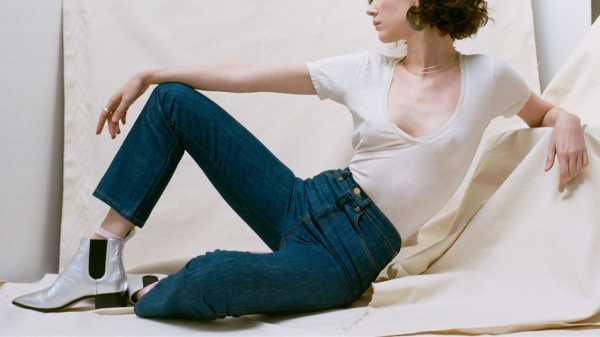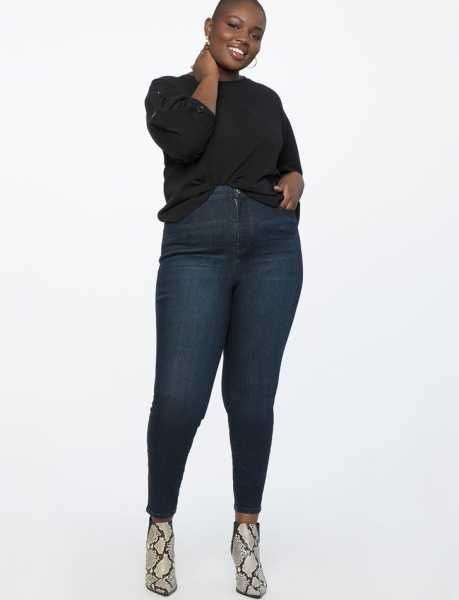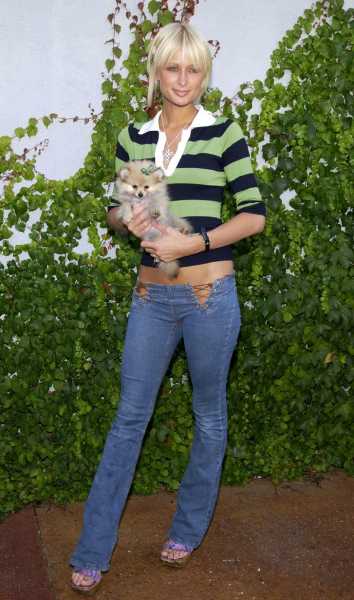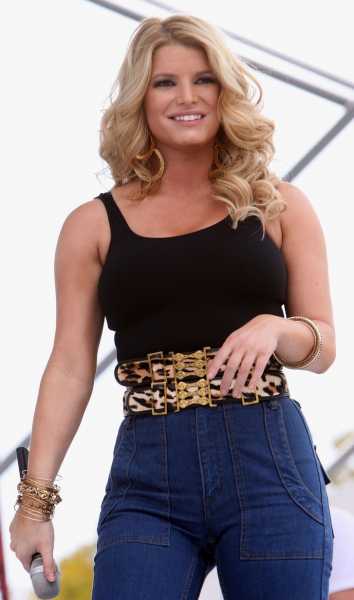
Inside Judi Rosen’s Nolita denim boutique is a mustard-yellow orb that sits with a satisfying weight in your palm, like an oversized 1-ball. Grafted onto its side is a small reflecting glass that you hold at shoulder level. This is the “butt mirror.” There you are, posing like Maleficent clutching a poisoned apple, with your back to a larger, full-length mirror. This double-reflection technique is familiar from any hairdresser’s, but in Rosen’s tiny dollop of a shop, on Elizabeth Street, which she opened earlier this year, this simple act of hindsight feels oddly illicit. We are not often asked to gaze upon our own full moons and assess their waxing dimensions. The human head never quite evolved to turn that way. The view can be a shock—not necessarily unpleasant, but uncanny. Evaluating your own backside, you feel both recognition and remoteness, as if meeting a distant cousin at a compulsory family gathering.
Rosen, who is forty-nine years old but has the spritely affect and bubbly drawl of an N.Y.U. undergrad, put the butt mirror into my hand on a recent October afternoon because she wanted to prove a point. Her point is that super-high-waisted jeans—a cut that Rosen first began pushing in the early two-thousands, when she owned a cult-popular downtown shop called the Good the Bad & the Ugly—make everyone’s rump look rounded and Rubenesque. I had just wriggled, with great effort, into a pair of her wide-legged stovepipe jeans, which have a thirteen-inch rise and come up past my sternum. Rosen’s jeans are meant to fit snugly, or, as she put it,“like a sausage.” Each pair comes with a tiny fabric flap printed with detailed instructions for getting them on: first, yank the pants over the derriere, then fasten the button, then hike them up another two inches, then zip. While I was in the dressing room grunting my way through these four steps, Rosen called out to ask if I was sweating yet. I told her I was considering lying down on the ground to get the zipper up; Rosen told me I would be far from the first customer to do so.
Some people might be annoyed by all this shimmying and wrenching, but I am no stranger to the effortful task of putting on high-waisted pants. In fact, I have come to love the process: the squeezing, the tugging, the hula-esque gyration required to pop the waistband over the hips. I do this little dance almost every morning, and it always requires a bit of a silent pep talk, an internal bolstering: two legs enter, one woman leaves. I’ve learned to appreciate whatever is necessary to achieve the only trouser silhouette I’ve ever enjoyed, one that cradles and cuddles the body as if it is holding my organs in place. For the past year or so, I have been on a hunt for higher and higher rises that are ever more difficult to worm into.
And I am not alone. In April, I posted on Twitter that “I would 100% shop monthly at a store that was just called ‘very good high-waisted pants for people with butts’ ” and was surprised to find that scores of people in my replies were engaged in a similar quest. As the author and critic Andrea Long Chu tweeted recently, “bring me the highest waist in all the land!”
High-waisted pants have been around regardless of gender, in various iterations, for centuries: Victorians in lofty tweed knickers attached to suspenders, zoot-suiters in thick pin-striped cotton that enveloped the navel, Katharine Hepburn in flowy wide-legged trousers that made her body resemble a golden statuette, seventies glam rockers in skin-tight bell-bottoms, the nineties proliferation of acid-wash mom jeans. What feels different about the current demand for skyscraper pants is the sentiment that they cannot ever be high enough—if the pants are not giving you an instant wedgie or a yeast infection, then they are too low-cut. Walk into any major retailer and you are bound to find a smorgasbord of form-fitting, lung-grazing options, many with a fly that is longer than a standard school ruler.

Eloquii’s Goldie jeans feature a rise of fourteen and a half inches.
Photograph Courtesy Eloquii
Jill Guenza, the vice-president of global women’s design at Levi’s, said that the twelve-and-an-eighth-inch rise on the brand’s new wide-legged Ribcage jeans—the highest-waisted offering in Levi’s history, which débuted a year ago—is “one of our most in-demand styles for women.” My pair of Sky High jeans, from the Gap, measured twelve inches from crotch to waist. The Australian brand Rolla’s, which is gaining popularity Stateside, has a duster jean that clocks in at the rise length of a Subway footlong. The Ne(X)t Level jeggings at American Eagle Outfitters almost skim the underboob region at twelve and a quarter inches. At Madewell, the Momjean, rolled out in August, clears the bellybutton with room to spare at twelve and a half inches, and their Paperbag jeans, which launched in September, sit even closer to the thorax, at thirteen inches. The Goldie high-rise jeans at Eloquii, a plus-size retailer, may be the highest of all, at fourteen and a half inches. (The popular basics brand Everlane, by comparison, is currently falling a few inches short, as their highest-rise denim, the Button-Fly Wide Leg Jean cut, goes up only to eleven and a half inches.)
Personally, I want my pants to be so high that they can double as an underwire bra. I want to feel like Humphrey Bogart playing an exaggerated version of himself for Halloween. As Rosen told me, giggling as she stood in her shop in a pair of rib-skimming marigold corduroy trousers of her own design, her ideal pants are meant to “lift and separate.”
When Rosen first started rolling out her thirteen-inch rises, in the early two-thousands, she said, she felt out of step with current trends. Certain high-fashion designers, like Nicolas Ghesquière, were sending nipple-grazing pants down runways—his fall 2002 collection for Balenciaga featured trousers that greatly resemble those every woman appears to covet today. For the most part, though, popular culture seemed entirely oriented toward low-cut styles. Midriff-baring Juicy tracksuits were de rigueur, and Britney Spears, when she wasn’t wearing a Burmese python, sported pants that exposed her hip bones. The cast of “The O.C.” seemed never to go anywhere without showcasing bellybuttons.
But Rosen wanted to look more like a louche, decadent rock star of the past. She started hunting down vintage denim but found that “old-school high-waisted jeans are just tubes,” and would not fit a more voluptuous, compact frame. If she could not source her dream fit in stores, she figured, she’d invent her own: tight and towering, with a rigid seam that scooped up the posterior.
She was not the only super-high-waist purveyor who felt ahead of her time. In 2005, Jesse Kamm, a former model living in Los Angeles, launched her own line of wide-legged, canvas sailor pants with a thirteen-inch rise, a style that she calls Kammpants, and which she said she created as a direct reaction to the hip-hugger trend. “When the world was into the really low-slung skinny pants, I just didn’t understand what was happening,” she said recently, on the phone from Los Angeles. “On my body, it didn’t feel right. Having structured, high-waisted pants makes you feel sort of hugged right, or supported in some way.” Fans of Kamm’s structured, belly-cinching styles include Dakota Johnson, Jenny Slate, and Jessica Alba. Much like the buzzy Rachel Comey Legion trousers, Kamm’s pants hit at the ankle and give you the proportions and general vibe of a woman working in the Brooklyn Navy Yard during the Second World War. They serve as a playful, high-femme in-joke. These are business pants, but they are also a bit silly, a bit exaggerated, suctioning in the midsection like a corset.
Kamm, who is forty-three, started a small fashion-world dustup last year when she complained that Google searches for “Jesse Kamm pants” served results for Madewell high-waisted pants, but lately she seems at peace with the extended-crotch proliferation. “There’s a tipping point when enough of the higher-end designers do their version of it, then the next phase is the mainstream market takes note and they do their version. . . . I’ll just take my piece of the pie, and that’s all good.” She has a system in her studio where, when a customer returns to her Web site to buy a second (or third, or fourth) pair of Kammpants, an employee will ring a bell. The bell rings several times a week. Recently, she said, “a supermodel got four pairs of the same style. Two in the size down and two pairs in the size up, for her period days and her skinny days.”
Once upon a time, Jessica Simpson performed a concert in a pair of high-waisted, wide-legged dark jeans that would be considered incredibly chic in 2019. But this was 2009, when antagonism for high-rise pants ran high enough that Simpson’s outfit became national news. She was pilloried for her style and her size. (One particularly ugly TMZ headline read, “This Is How She Rolls.”) She later told Oprah Winfrey that she found the backlash ridiculous and that she prizes her hourglass shape, but admitted that “the mom-jeans situation” sent her into a depressive spiral.

Low-rise pants, as worn by Paris Hilton, are walking billboards for extreme thinness and androgynous frames.
Photograph by Jean-Paul Aussenard / WireImage / Getty

Jessica Simpson was pilloried in 2009 when she performed a concert in a pair of high-waisted, wide-legged dark jeans—pants that would be considered incredibly chic in 2019.
Photograph by Logan Fazio / Getty
How did we go from considering high-rise pants a sartorial horror to being an object of pleasure and delight? We are “at the top of the pendulum swing from the extremely low-rises of the early to mid-two-thousands,” the fashion writer Samantha Powell told me. “And stretch in denim meaning that you can have rises that high without hindering your ability to breath normally, for the most part.” At the same time, she noted, high-rise pants exist “in opposition to the ease of athleisure.” In other words, the structure and strictures of the high waist allows a person to feel immediately pulled together, and not at all casual. Wearing a high-rise pant, you feel like you have really gotten dressed—like all that wiggling and hiking has resulted in a visible transformation. Low-rise pants are walking billboards for extreme thinness and androgynous frames, but high-rise styles can conform to bodies of all shapes and sizes. They not only highlight hips and butts—they demand them.
“My body type truly sings in a high-waisted pant,” the New York-based cookbook author Alison Roman told me, via text. “I have a bigger butt and a lot of thigh and an extremely long torso. The high waisted pant keeps all of my puffier parts (i.e. belly) looking and feeling tucked in. . . . There is also a timelessness to them, for me, at least. And by timeless, I mean the 70’s, the time I wish to eternally channel.”
MORE FROM
On and Off the Avenue

Virtue and Vanity at Reformation

Jenny Slate’s Netflix Special Is All About the Joy of Getting Dressed

Let’s Talk About the Yacht Clothes on “Succession”

The Age of Bathfluence

Rihanna’s “Savage X Fenty Show” Puts a Super-Fun Face on End-Stage Capitalism

Tender Buttons, a One-of-a-Kind New York Institution, Closes Shop
The film critic Amy Nicholson, who lives in Los Angeles, told me that she never wore pants at all before the extreme high waist came back into fashion, because most cuts made her look boxy or squat. “I never even owned a pair of jeans until 2012. And now I have thirty pairs,” she said. She added that she is so loyal to her “patient zero” pair of high-rises from Topshop that she has taken them to a tailor to be mended twice.
“I didn’t like wearing pants. I wore them as little as possible,” the Brooklyn-based writer Ashley Ford told me over the phone. “I have P.C.O.S.”—polycystic-ovary syndrome—“and one of the symptoms is having a pot belly, which started for me when I was seventeen. That was tough—Britney Spears was everywhere, and Ciara. Those low-rises were low, baby.” It was not until two years ago, when Ford was sent a pair of Loup Simone jeans, that she realized she could wear pants at all. Now, she said, she has gone on a shopping spree, buying up high-waisted jeans at Target and investing in two pairs of pricey silk trousers from Elizabeth Suzann.
Gazing into the butt mirror at Judi Rosen, I realized the appeal of the hyperbolically high-waisted pant may be in how much the cut emphasizes and celebrates natural curves. I, too, grew up in the era of low-rise skinny jeans, and I, too, avoided pants altogether for years. I thought that pants were meant to hide my shape, or at least streamline it in a kind of disappearing act. I was taught to draw the eye upward, toward a statement earring or a pussy bow: ceci n’est pas my hips. So when I tried on my first pair of high-waisted pants (I found my gateway pair, the Levi’s Wedgie jeans, in 2018), I almost broke out laughing. All these years, we had been lied to! Pants can glorify the body rather than mask it. High-rise pants put us in a direct, friendly confrontation with our proportions. Perhaps women are less afraid to have that interaction now, or perhaps we’ve just grown tired of draping ourselves in euphemism when we could just draw attention to what is there, and embrace it, literally, from every angle. You wear high-rise pants as much for yourself as for others—the act of wiggling them on becomes a ritual, an entrance into a secret club, a sign that you are not afraid to look behind you to see what’s coming next.
Sourse: newyorker.com



